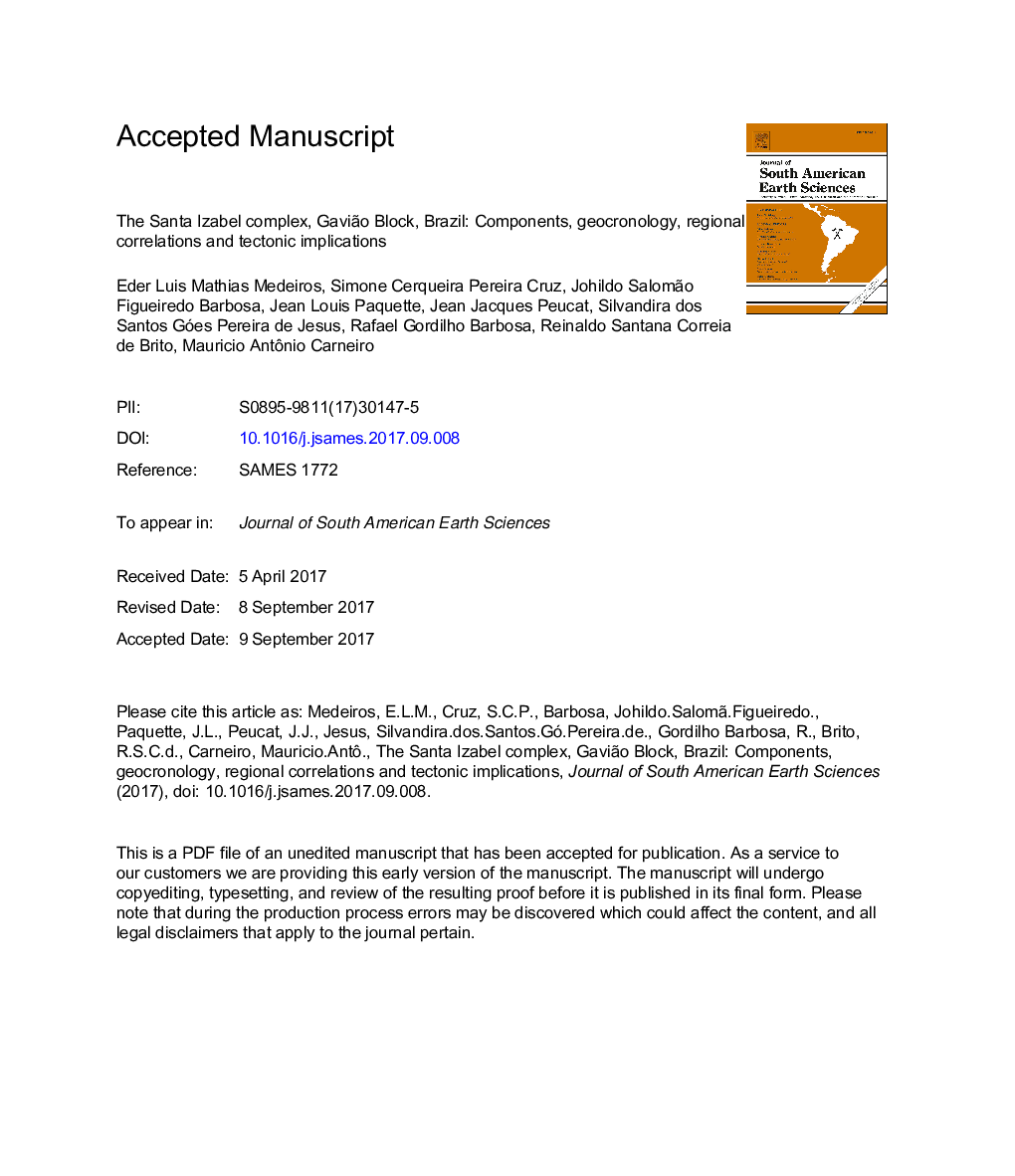| کد مقاله | کد نشریه | سال انتشار | مقاله انگلیسی | نسخه تمام متن |
|---|---|---|---|---|
| 5780335 | 1635130 | 2017 | 69 صفحه PDF | دانلود رایگان |
عنوان انگلیسی مقاله ISI
The Santa Izabel Complex, Gavião Block, Brazil: Components, geocronology, regional correlations and tectonic implications
دانلود مقاله + سفارش ترجمه
دانلود مقاله ISI انگلیسی
رایگان برای ایرانیان
موضوعات مرتبط
مهندسی و علوم پایه
علوم زمین و سیارات
علوم زمین و سیاره ای (عمومی)
پیش نمایش صفحه اول مقاله

چکیده انگلیسی
Cratons, as well as the basement of their marginal orogens, may represent important sites of research regarding the formation and evolution of Archean continental crusts. The Gavião Block is one of the oldest terranes in South America with rocks aged up to 3.6 Ga. Among the Archean units that outcrop in the southern sector of this block is the Santa Izabel Complex, which for the most part is located in the São Francisco Craton, close to its limit with the AraçuaÃ-West Congo Orogen. This complex has generally been described as comprising ortho- and paraderived rocks that were metamorphosed in high amphibolite facies. Studies in the southern region of this complex have shown the main components: (i) orthogneisses, whose protoliths are the Mesoarchean rocks of the Santa Izabel Magmatic Suite; and (iii) migmatites. and (iv) amphibolitic and metaultramafic enclaves. U-Pb studies (LA-ICPMS and SHRIMP) performed on zircons of the paleosome in metatexites and inherited zircons in migmatites indicate crystallization ages between 3091 ± 24 and 3136 ± 8 Ma for the rocks of the Santa Izabel Magmatic Suite. Inherited zircons aged ca. 3.4 Ga in paleosomes demonstrate the influence of older continental crust in the formation of these rocks. For the Caraguatai Magmatic Suite, the alignment of zircons and monazites suggests a crystallization age around 2.6 Ga. The Rhyacian migmatites were divided into metatexites and diatexites. Diatexites were divided into: (i) discontinuous boudinated early diatexites, which are parallel to stromatic metatexites, composing the gneissic banding. These rocks have diffuse metamorphic banding and features that suggest the action of mylonitization processes; and (ii) late diatexites, forming more continuous bodies, which truncate the gneissic banding. The migmatization occurred in two stages, with time interval between ca. 2.1 Ga and 2.07 Ga. The structural framework reveal the existence of four progressive Rhyacian deformation phases (Dn to Dn+3), and one deformation phase assumed to be Ediacaran (Dn+4). Gneissic banding is the dominant structure and lithofacies of the Santa Izabel and Caraguatai Magmatic suites, in which metatexites and late diatexites alternate between themselves. This progressive deformation occurred in conditions of high amphibolite facies, with stress fields varying between NW-SE and WSW-ENE. The youngest phase, Dn+4, was associated with distal deformations related to the evolution of the intracontinental AraçuaÃ-West Congo Orogen with a WSW-ENE stress field. The combined data suggest a complex evolution for the Gavião Block, involving juvenile accretion, crustal reworking, deformation and metamorphism/migmatization from the Paleoarchean to the early Rhyacian. Almost all elements of the evolutionary stages of the Gavião Block can be recognized in the study area, setting it as a natural laboratory to unravel the evolutionary history of this sector of the South American continental crust.
ناشر
Database: Elsevier - ScienceDirect (ساینس دایرکت)
Journal: Journal of South American Earth Sciences - Volume 80, December 2017, Pages 66-94
Journal: Journal of South American Earth Sciences - Volume 80, December 2017, Pages 66-94
نویسندگان
Eder Luis Mathias Medeiros, Simone Cerqueira Pereira Cruz, Johildo Salomão Figueiredo Barbosa, Jean Louis Paquette, Jean Jacques Peucat, Silvandira dos Santos Góes Pereira de Jesus, Rafael Gordilho Barbosa, Reinaldo Santana Correia de Brito,